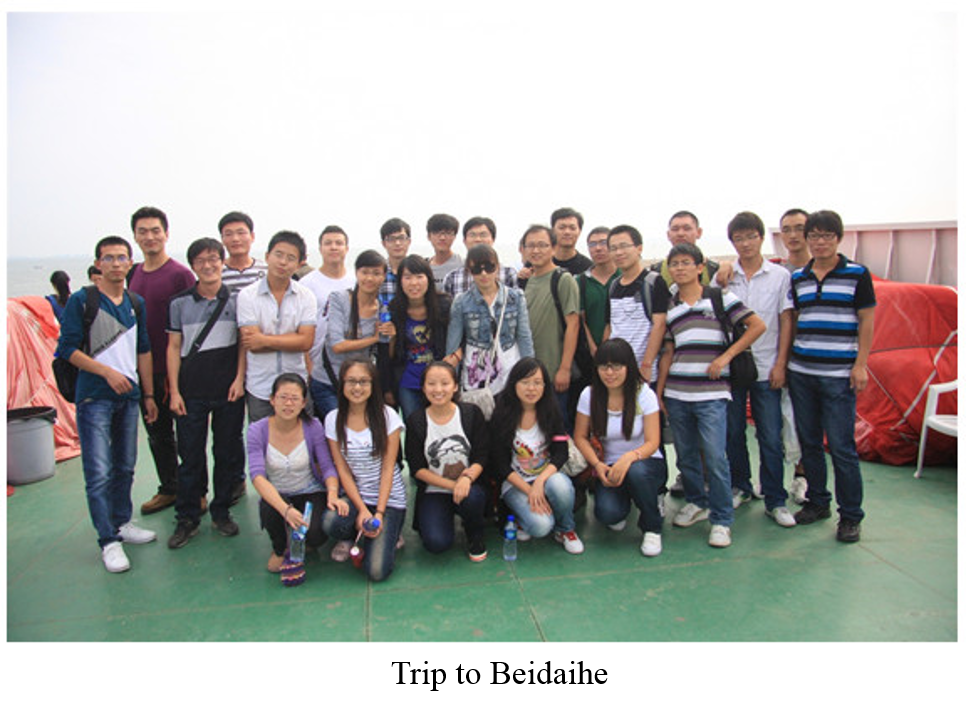Institute of Powder Metallurgy
Reaction Synthesis and Nanomaterials Laboratory
【Laboratory Introduction】
The Reaction Synthesis and Nanomaterials Laboratory is affiliated to the Institute of Powder Metallurgy, University of Science and Technology Beijing, in which there are 6 teachers. This laboratory is mainly engaged in the research and application of powder metallurgy Ti alloy, Al alloy, Cu alloy, 3D gel-printing technology, Radio frequency inductively coupled plasma spheroidization technology, SHS, nanometer and ultrafine powder preparation technology, gel-casting technology of metal powder, dispersion strengthened materials, super crystalline cemented carbides, surface coating, diamond tools, magnetic nano-powder, magnetic fluid, and other advanced powder metallurgy materials and technologies. Scientific research projects undertaken include National Natural Science Foundation Projects, National 863 Projects, National 973 Projects, National Key R&D Program of China, and cooperation projects with enterprises. A number of researches won the provincial and ministerial science and technology progress awards, and have been applied in the industrial production, which have obtained significant social and economic benefits.
and have been applied in the industrial production, which have obtained significant social and economic benefits.
【Team members introduction】
|
|
|
|||
Zhimeng Guo |
Junjie Hao |
Huiping Shao |
Ji Luo |
Cunguang Chen |
Fang Yang |
Zhimeng Guo, Professor, PhD supervisor, Director of Institute of Powder Metallurgy
Junjie Hao, Professor, PhD supervisor
Huiping Shao, Associate Researcher, Master Tutor
Ji Luo, Associate Researcher, Master Tutor
Cunguang Chen, Lecturer
Fang Yang, Lecturer
【Research interests and achievements】
1、Production technology of powder metallurgy Ti and Ti alloys with low cost
This laboratory has been engaged in the preparation of titanium and titanium alloy powder, advanced near-net forming technology and consolidation technology of titanium powder for many years. At present, a complete core technology system with independent intellectual property rights has been built, and we are promoting the research and development achievements to the military and civil products markets, and have made significant progress. We have obtained titanium alloy powder with particle size ≤ 10 μ m and oxygen content ≤ 1000 ppm through strict oxygen control technology. Besides, as-sintered Ti-6Al-4V alloys have been prepared with relative density greater than 99% via cold isostatic pressing and vacuum pressureless sintering. The oxygen content of as-sintered titanium alloy is less than 1000 ppm, the nitrogen content is less than 200 ppm and the hydrogen content is less than 100 ppm. The as-sintered titanium alloy has tensile strength ≥ 950 MPa, yield strength ≥ 880 MPa, and elongation ≥ 14%. After forging, the titanium alloy has tensile strength ≥ 1030 MPa, yield strength ≥ 980 MPa, elongation ≥ 16%, and high fatigue performance (low cycle fatigue strength > 800 MPa). The components and properties of the as-sintered titanium alloy meet the requirements of ASTM B348. Furthermore, a precision forging technology is employed to forge the near-net shaped as-sintered titanium ingot at ultra-high temperature, and thus preparing complex-shaped titanium alloy parts, including special vehicle track shoes and automobile connecting rods.
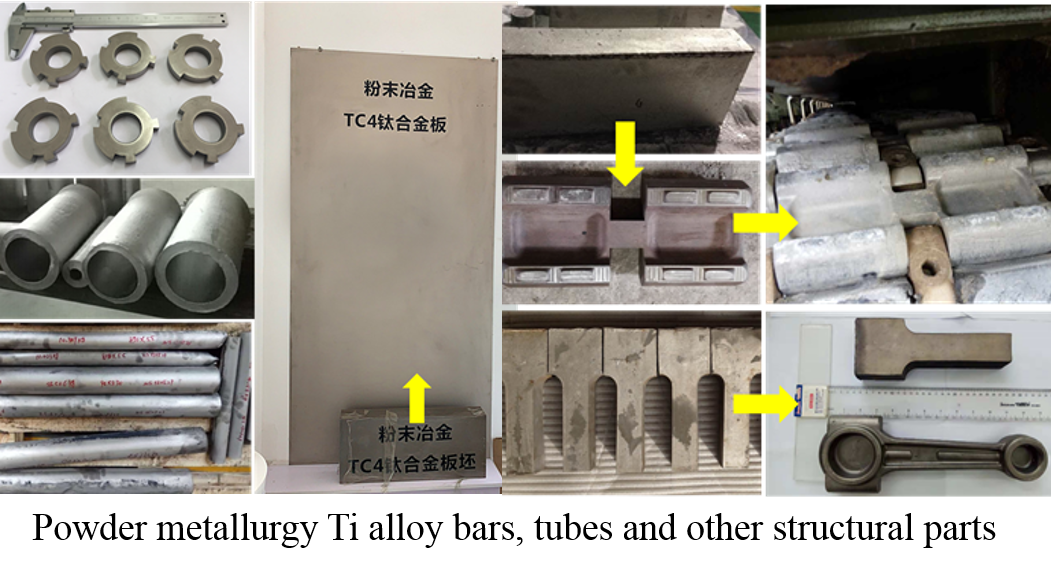
2、Production technology of powder metallurgy Al and Al alloys
This laboratory has been engaged in the research of powder preparation, advanced forming and sintering technology of aluminum and aluminum alloy for many years, and has formed a complete core technology system with independent intellectual property rights. Breaking through the key technologies including the preparation of ultrafine aluminum alloy powder without segregation, large-size and complex-shaped compacts via cold isostatic pressing, activation sintering for densification and plastic processing, we have developed a variety of high-end PM aluminum alloy products with large size, high strength and ultra-high strength, including profiles, plates and forgings. The as-sintered PM aluminum and aluminum alloy have a homogeneous and dense microstructure with fine grain size of 10~20 μm. After thermal deformation process, the grain size decreases to 1~5 μm. The tensile strength, yield strength and elongation of the PM 2000 series aluminum alloy are 600 MPa, 450 MPa and 9.8%, respectively, while those of the PM 7000 series aluminum alloy are 810 MPa, 770 MPa and 8%, respectively. Compared with the traditional cast aluminum alloy, the mechanical properties of P/M aluminum alloy are improved by more than 15%. Meanwhile, complex-shaped PM aluminum alloy parts, including automobile bearing cover and CVT gearbox rotor, are successfully prepared by the pressing and activating sintering technology. To date, more than 20 related invention patents have been applied, and more than 10 related academic papers have been published.
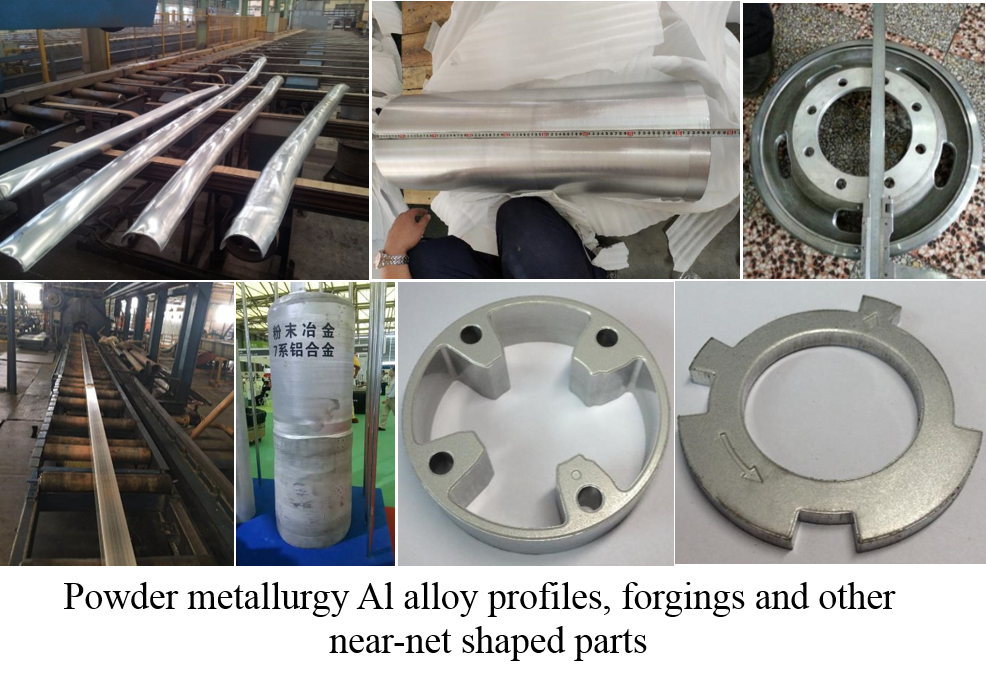
3、Production technology of powder metallurgy Cu and Cu alloys
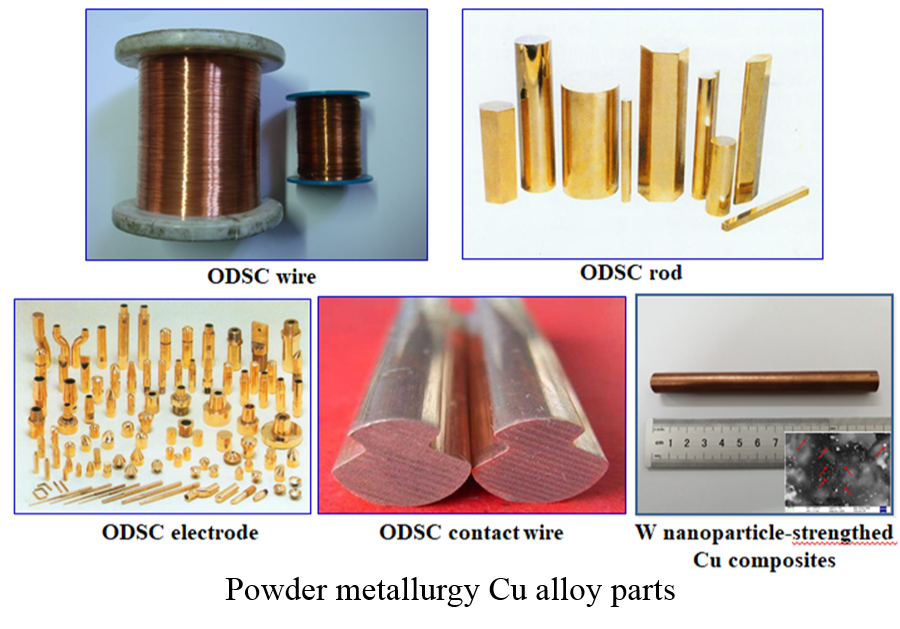
After more than 10 years of research, this laboratory has gained rich achievements in copper and copper alloy. On this basis, a number of related research projects have been undertaken, including National "863" project - High performance PM materials and its advanced preparation technology, subproject: Microstructure regulation and densification technology of oxide dispersion strengthened PM material; Guangdong Province Production and Research Project - High value utilization research and industrialization of waste etching solution of electronic circuit board. To date, our group possesses a solid foundation in PM copper and copper alloy and has prepared a series of dispersion strengthened copper products, which have been realized industrialization, including rods, wires, electrodes and crystallizers. The ODSC products with 0.5 wt.% Al2O3 introduction prepared by internal oxidation have tensile strength of 520 MPa, softening temperature of 850 °C, and conductivity of 86% IACS, which reach the GLIDCOP AL-25 level. Meanwhile, this laboratory took the lead in proposing the theory of metal dispersion strengthened material and conducting related research. Nano-tungsten dispersion strengthened copper with 6 wt.% W has a uniform microstructure with W particle size of 119 nm. The tensile strength, hardness, and conductivity reach to 310 MPa, 108 HV, 90% IACS.
4、Radio frequency inductively coupled plasma spheroidization technology
Due to the advantages of high temperature (104 °C), large volume of plasma torch, high energy density, no electrode contamination, fast heat transfer and fast cooling rate, radio frequency (RF) inductively coupled plasma processing technology is a promising way to prepare spherical powder with uniform composition, high sphericity and good fluidity. The 100KW RF plasma device developed by this laboratory is stable in operation and low in cost. It successfully realizes the spheroidization treatment of refractory metals, alloys and ceramic powders, and has achieved batch production of spherical titanium powder with the production cost reduced by more than 50%. Related researches have funded by the National “863” Program, the National Natural Science Foundation Project and the Doctoral Scientific Fund Project. More than 10 academic papers have been published. Besides, 2 international invention patents and more than 10 domestic invention patents have been authorized.

5、Liquid precipitation technology for preparing ultrafine alloy powder
The precursor of complex metal oxide is prepared by the liquid precipitation method, and then ultrafine alloy powders are obtained by hydrogen co-reduction of the precursor, including Fe-Ni, Fe-Co-Ni, Fe-Co-Cu, Cu-Sn, Co-Cu-Sn, Fe-Ni-Cu-Sn, and so on. This method is of simple process, low production cost and shorter process, which is suitable for achieving scale production. Related products play a positive role in promoting diamond tools and other industries. This project has been cooperated with enterprises to realize industrial production.
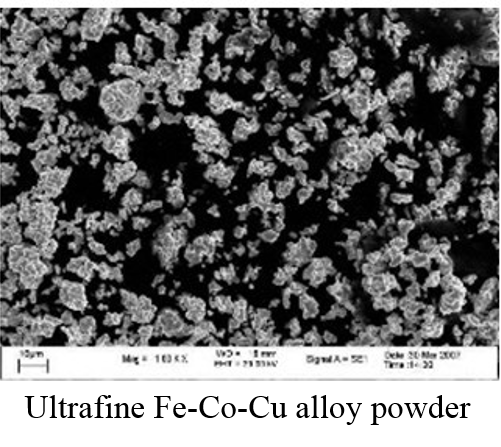
6、3D gel-printing technology
3D printing, also known as additive manufacturing (AM), is one of rapid manufacturing technologies to obtain a three-dimensional object, which is different from the traditional processing technology of removing materials. Based on the dispersion-deposition fundamental, continuous layers of material are laid down under computer control. 3D printing technology integrates the frontier knowledge and technology in digital modeling, electromechanical control, information, materials science and chemistry, etc. It is often applied in the mold manufacturing, industrial design and directly product production. In this laboratory, 3D gel-printing technology has proposed through the combination of 3D printing and gel-casting. Highly loaded metal or ceramic slurry is used as the printing materials. Instead of high energy beam forming, the slurry is extruded and deposited followed by in-situ curing layer by layer under the computer control to obtain the complex-shaped metal or ceramic parts. It has the advantages of low cost, near-net forming of complex-shaped parts, low requirement of raw materials and broad applicable prospects.

7、Gel-casting technology
In gel-casting for metal powder, highly loaded slurry with low viscosity is prepared with suitable gel system for different metal powders. The rheological properties, suspension mechanism and gelation law are systematically investigated, which lay a foundation for the low-cost industrial production of large-sized (single weight than 8kg) precision metal parts. Suitable metal powder types include stainless steel, titanium, aluminum, and so on.
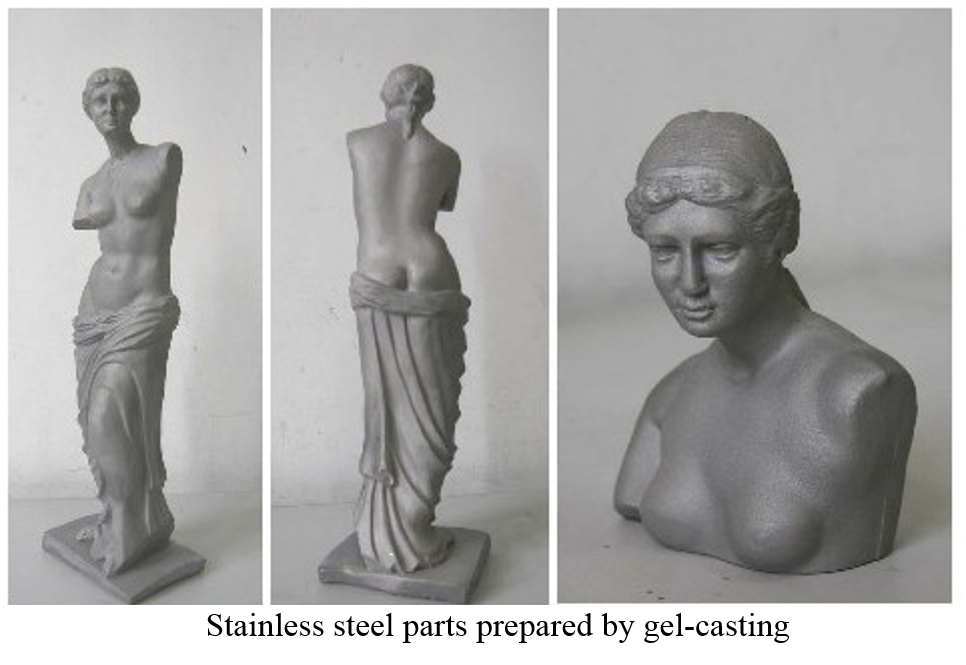
8、Medical porous titanium alloys
Porous titanium alloy is considered to be a promising replacement material of artificial bone due to its open porous structure, allowing the growth of new bone cells and the transportation of body fluids. Besides, its strength and Young's modulus can be matched with the natural bone by adjusting the porosity. However, medical porous implant materials are complex in shape with abundant details and variable in size from person to person, which requires low cost for small-scale production. Based on this, this laboratory combines gelcasting technology with self-propagating high-temperature synthesis technology to prepare porous titanium and titanium alloy parts. The technology is of great significance to achieve the production of large-size and complex-shaped implant materials with high porosity, high open area, and uniform macroscopic pore distribution. The project was funded by the National Natural Science Foundation of China.
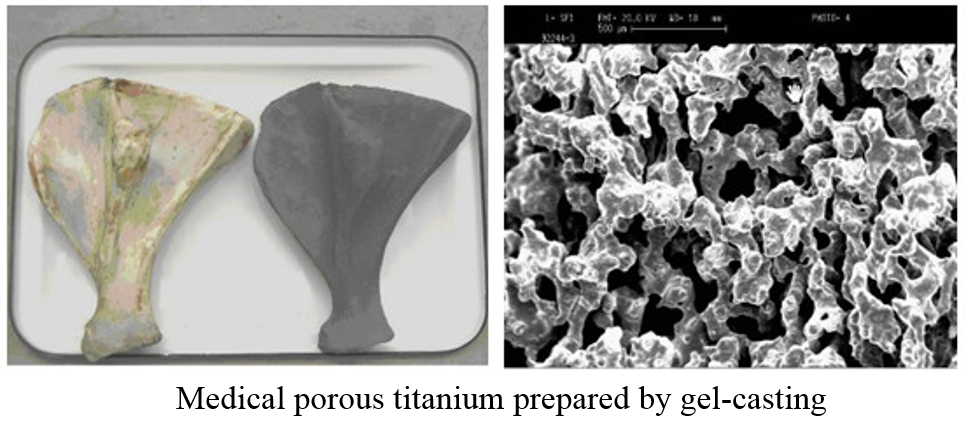
9、Self-propagating high-temperature synthesis technology for preparing ceramic-lined steel pipes
Ceramic-lined steel pipes have excellent comprehensive properties in wear resistance, corrosion resistance, heat resistance, thermal shock resistance and mechanical shock resistance. It can be widely used in metallurgy, electric power, petroleum, chemical and construction industries. It can be used for the transportation of pulverized coal, ash, mineral powder, tailings, backfill, coke, cement, concrete, aluminum liquid and corrosive medium. When the thermite is ignited, both the ceramic phase and the metal phase of the combustion products are in the molten state. The liquid ceramic phase and the metal phase having different specific gravities are separated by an external force (centrifugal force or gravity). Consequently, the ceramic phase with a small specific gravity will solidify on the surface layer to form a ceramic inner liner of the steel tube. This project is a key research project of the National 863 Program. It is also a key industrialization project in the new material field of the National 863 Program and a key promotion project of the National Science and Technology Commission during the “Ninth Five Year Plan” period. It won the fourth prize of National Scientific and Technological Invention, second prize of Scientific and Technological Progress of the Ministry of Education

10、Dispersion strengthened materials
Dispersion strengthening method depends on introducing stable, uniform and fine particles into the metal matrix to pin dislocations, grain boundaries and sub grain boundaries to obtain high strength. Active metal oxides have high stability and are often used as reinforced phases of dispersion strengthened metals, which are called as Oxide Dispersion Strengthened (ODS) materials. The project is supported by the National 863 Project. For example, ODS copper has higher strength and excellent electrical and thermal conductivity (>90%) compared with pure copper. The ODS Cu with Al2O3 dispersion particles has the characteristics of strength ≥600 MPa, hardness ≥ 90 HB, softening temperature up to 850-910 °C, good yield strength after annealing, high fatigue strength and excellent cold working performance. Besides, the grain size of alumina particles in the ODS Cu is about 10 nm, and the distance between the particles is about 30-50 nm with diffusion even.
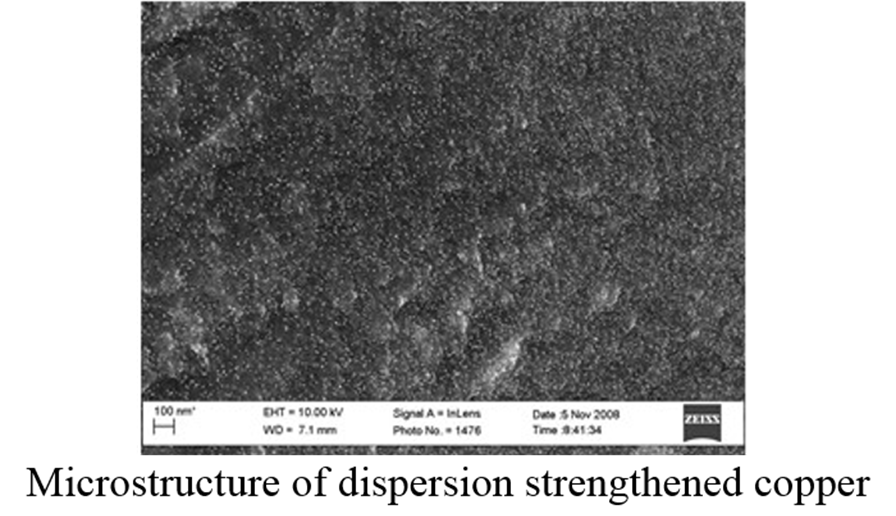
Furthermore, Y2O3 dispersion strengthened pure iron and steel are also prepared. The room temperature tensile strength of Y2O3 dispersion strengthened pure iron is about to 570 MPa, which is twice as much as that of pure iron. On this basis, the dispersion strengthened low activation ferrite/martensite steel are prepared. The tensile strength is up to 1200 MPa. The fine oxide particles distribute uniformly in the matrix.
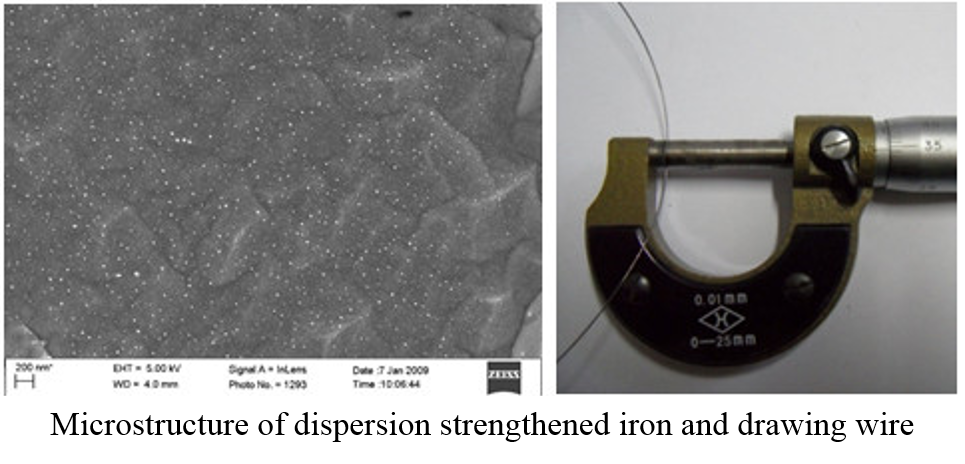
Besides, the dispersion strengthened pure aluminum, 2024 Al alloy and 2A50 Al alloy with excellent properties are prepared. The tensile strength of dispersion strengthened pure aluminum is more than 200 MPa, while that of the ordinary pure aluminum is 80 MPa. The conductivity of the dispersion strengthened pure aluminum is 62 IACS%, which reaches to 96% of ordinary pure aluminum. The tensile strength, yield strength and elongation of dispersion strengthened 2024 aluminum alloy are 612 MPa, 480 MPa and 10%, respectively.
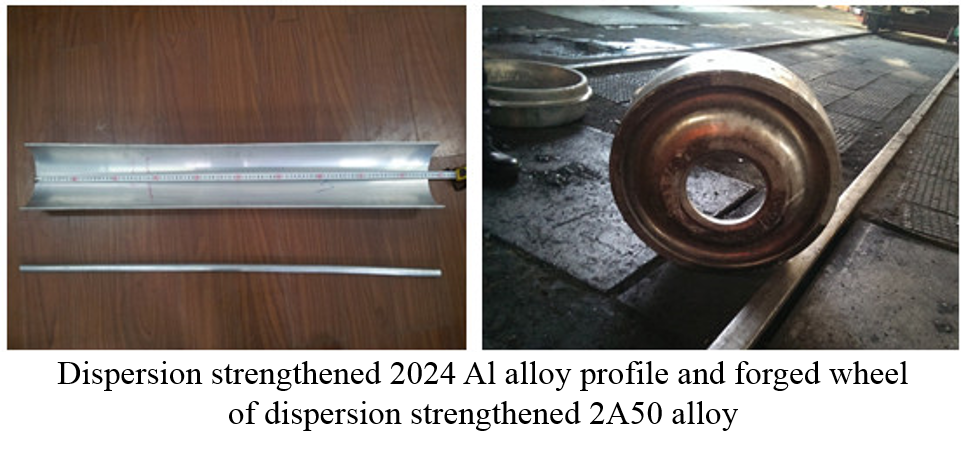
11、Cladding coating technology
The cladding coating technology is a powder metallurgy process, in which the binder phase (generally, low melting point self-fluxing alloy powders such as Fe-based, Ni-based, Co-based, etc.) and the hard phase powder (such as carbides, borides, nitrides, etc.) are mixed in a certain ratio and applied to the substrate surface. The powder is heated a semi-molten state followed by diffusing and mutually melting with the matrix to achieve metallurgical bond. Therefore, a firm metallurgically combined hard coating of high abrasion resistance, corrosion resistance, high temperature resistance and oxidation resistance is obtained on the matrix surface. The cladding coating has high bonding strength with the substrate (330~380 MPa) and high hardness (59~64 HRC). The dense coating is of good surface quality without pores, cracks and other defects. This technology can be applied to oil pipes, sucker rods, couplings and oil pipes in the petroleum industry, rolls in the metallurgical industry, various rolling guides, sliding guides, and refractory brick molds. In addition, the technology can be also applied to mud pump cylinder liners, grinding hammer, and various molds that require wear and corrosion resistance. The project has been cooperated with enterprises to achieve industrial production.
The cladding coating technology is a powder metallurgy process, in which the binder phase (generally, low melting point self-fluxing alloy powders such as Fe-based, Ni-based, Co-based, etc.) and the hard phase powder (such as carbides, borides, nitrides, etc.) are mixed in a certain ratio and applied to the substrate surface. The powder is heated a semi-molten state followed by diffusing and mutually melting with the matrix to achieve metallurgical bond. Therefore, a firm metallurgically combined hard coating of high abrasion resistance, corrosion resistance, high temperature resistance and oxidation resistance is obtained on the matrix surface. The cladding coating has high bonding strength with the substrate (330~380 MPa) and high hardness (59~64 HRC). The dense coating is of good surface quality without pores, cracks and other defects. This technology can be applied to oil pipes, sucker rods, couplings and oil pipes in the petroleum industry, rolls in the metallurgical industry, various rolling guides, sliding guides, and refractory brick molds. In addition, the technology can be also applied to mud pump cylinder liners, grinding hammer, and various molds that require wear and corrosion resistance. The project has been cooperated with enterprises to achieve industrial production.
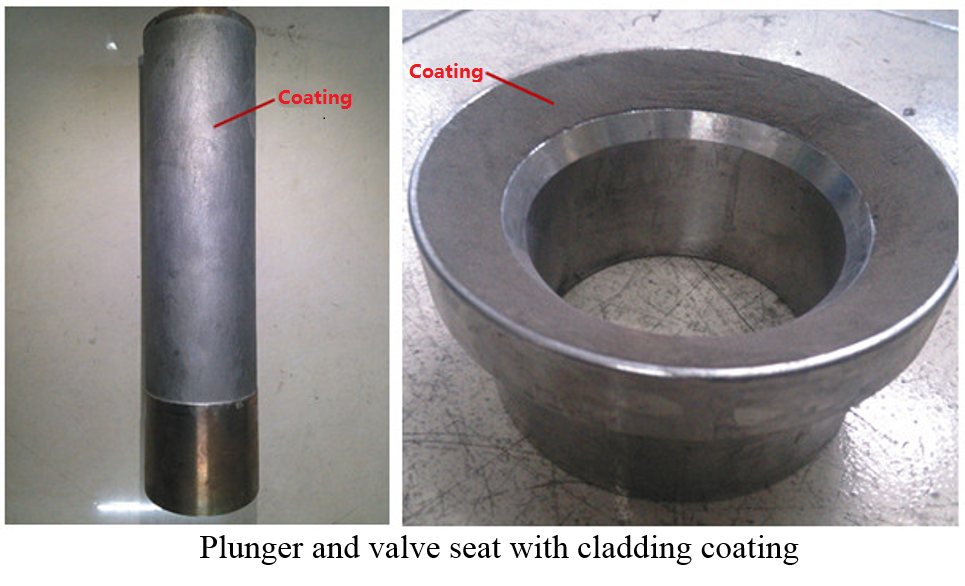
12、High-density silicon nitride ceramics prepared by atmosphere pressure sintering
High-density silicon nitride ceramics are prepared by the combination of atmospheric pressure sintering and hot isostatic pressing. Through powder modification, the silicon nitride powder is activated and pre-treated followed by cold isostatic pressing to obtain near-net shaped ceramic body with high strength. Subsequently, high-performance silicon nitride ceramics are prepared by combining atmospheric pressure sintering and hot isostatic pressing. With high density, high precision, excellent thermal shock performance and high thermal conductivity, the mentioned silicon ceramic is widely used in the field of high temperature structure ceramics and high-seismic structure ceramics.
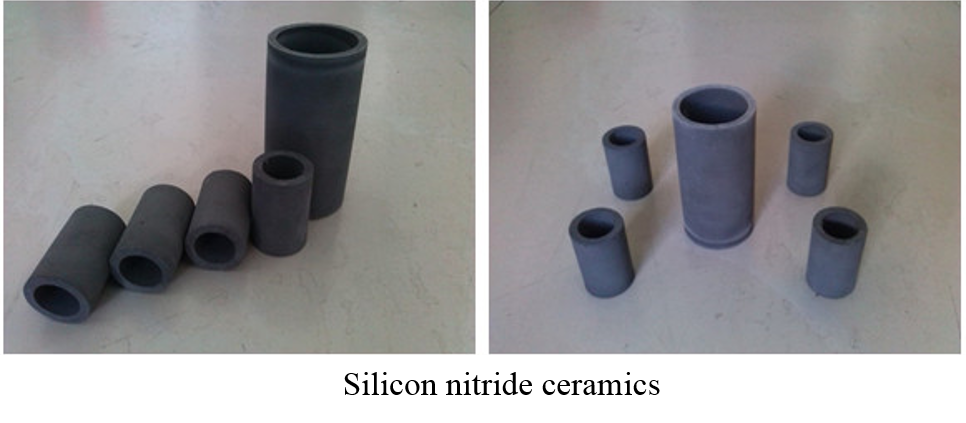
13、PM copper based brake fraction material
Copper-based brake pads are prepared by a powder metallurgy technology (powder mixing-pressing-pressure sintering). By analyzing the role of matrix component, friction component and lubrication component of brake pad, the composition is adjusted to obtain the copper-based PM brake pad with excellent performance. Furthermore, by surface modification of the friction component, the copper-based PM brake friction materials still possess high strength, suitable friction coefficient, good wear resistance, anti-adhesion and high temperature stability although in large temperature difference, wet, dry and other harsh environmental conditions. It can be applied to brakes of heavy machinery, such as wind turbines and high-speed trains.

14、Preparation methods of magnetic nano-powder and magnetic fluid
Magnetic fluid is a stable colloidal system formed by uniformly dispersing nanometer-sized magnetic particles in carrier liquid. It has both liquid fluidity and magnetic properties of magnetic materials, and is a novel nano-functional material, which widely used in rotary sealing, biomedicine, and magnetic recording, oil field mining and other fields. In our study, magnetic particles were prepared by chemical co-precipitation method. Then, surfactant was added, and ultrasonically dispersed in the carrier liquid to form a magnetic fluid. Stable kerosene-based and silicone-oil-based Fe3O4 magnetic fluids have been prepared with excellent performance.
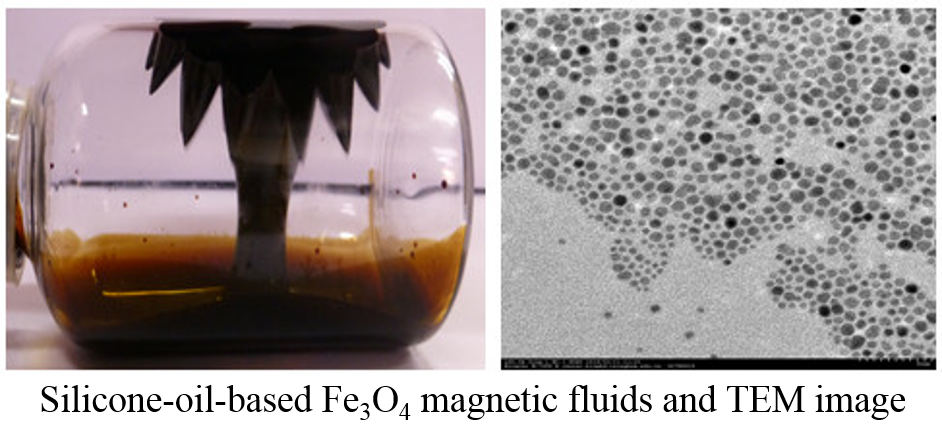
【Research projects】
· 1. Military Products Supporting Project of National Defense Science and Industry Bureau, 18.6 million, 2016-2020;
· 2. National Key R&D Program of China: Research on medical additive manufacturing high-purity titanium and titanium alloy powder, 660000, 2016-2020;
· 3. Beijing Science and Technology Plan Project: Research and application verification of 3D cold printing of metal matrix composite materials including equipment and raw materials, 1.198 million, 2015-2016;
· 4. National 863 Project: Microstructure regulation and densification technology of oxide dispersion strengthened PM material, 2.247 million, 2013-2015;
· 5. NSFC Project: Research on the behavior of TiH2 powder in RF plasma, 790000, 2012-2016;
· 6. Doctoral program of the Ministry of Education: Basic research on the preparation of spherical NdFeB magnetic powder by instantaneous hydrogen explosion plasma spheroidization technology, 120000, 2013-2015;
· 7. Key Technology Research Projects of Strategic Emerging Industries in Guangdong Province: Research and industrialization of SHS cladding steel bonded cemented carbide coating, 3 million, 2012-2015;
· 8. Production and Research Project of the Education Ministry and Science & Technology Ministry of Guangdong Province: Innovation platform of production research integration of cemented carbide common technology, 300000, 2012-2014;
· 9. Guangdong Province Production and Research Project: High value utilization research and industrialization of waste etching solution of electronic circuit board, 320000, 2013-2015;
· 10. Cooperation Project with Enterprise: Research of titanium alloy powder and products, 2 million, 2016-2026;
· 11. Cooperation Project with Enterprise: Research of 2000 t/y high-performance PM die steels via hot isostatic pressing, 4 million, 2015-2020;
· 12. Cooperation Project with Enterprise: Self propagating cladding wear-resistant coating technology for iron-based materials, 9 million, 2012-2022;
· 13. Cooperation Project with Enterprise: Research and industrialization of PM brake pads, 2 million yuan, 2012-2022;
· 14. Cooperation Project with Enterprise: Magnetic functional paper, 500000, 2013-2018;
· 15. Cooperation Project with Enterprise: Research of ferroalloy powder for friction plate, 200000, 2010-2015.
【Research team building】
The Reaction Synthesis and Nanomaterials Laboratory is a positive, enthusiastic and unity team. We pay serious efforts to perform the research. At the same time, we unite and help each other in life. Under the leadership of the teachers in the team, we make progress and grow up together. On this basis, many important scientific research projects have been completed. Besides, a lot of colorful activities have been carried out in the spare time of work and study, including dinner party on New Year’s day, autumn outing, and badminton, etc. During the play and entertainment, we enhance the feelings and cultivate teamwork awareness.

